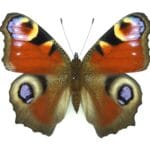Unveiling the Secrets of the Peacock Butterfly
The Peacock butterfly (Aglais io), a vibrant and easily recognizable species, captivates with its intricate wing patterns and remarkable life cycle. From its intriguing defense mechanisms to its vital role in the ecosystem, this guide explores the fascinating world of the Peacock butterfly, offering insights into its identification, life cycle, habitat, and conservation.
Identifying the Master of Disguise
The Peacock butterfly’s most distinctive feature is its striking wing pattern. The prominent “eyes” aren’t merely decorative; they serve as a powerful defense mechanism. When threatened, the butterfly flashes these eyespots, likely startling potential predators such as birds and giving the butterfly a chance to escape.
Beyond the eyespots, the Peacock butterfly displays a rich tapestry of colors, typically a reddish-brown base accented with black and cream markings. This intricate design may also aid in camouflage when the butterfly is at rest, providing another layer of protection. Some experts believe the color pattern may also play a role in mate selection.
A Transformative Journey: The Peacock Butterfly Life Cycle
The Peacock butterfly, like all butterflies, undergoes a complete metamorphosis—a remarkable transformation from a tiny egg to a winged wonder.
Egg: The female butterfly meticulously lays her pale green eggs in clusters on the underside of stinging nettle leaves ( Urtica dioica ), the sole food source for the larvae.
Caterpillar (Larva): After hatching, the jet-black caterpillars, adorned with spiky bristles, begin their voracious consumption of nettles. They grow rapidly, molting several times over a period of about two weeks, reaching lengths of 40-45mm. The caterpillars are initially gregarious, living communally in silk webs.
Pupa (Chrysalis): Upon reaching full size, the caterpillar forms a chrysalis—a hardened, protective casing—where the astonishing transformation into a butterfly occurs. This stage lasts approximately two weeks, during which a complete reorganization of tissues takes place.
Adult (Butterfly): The adult butterfly emerges from the chrysalis with soft, crumpled wings, which quickly expand and dry, revealing the iconic peacock pattern. The adult butterfly then focuses on feeding, mating, and laying eggs, continuing the cycle. Its lifespan is remarkably long for a butterfly, about 11-12 months. This includes an overwintering period in a state of dormancy.
Habitat and Distribution: A European Resident
The Peacock butterfly is a common sight across Europe, including the British Isles, extending eastward into temperate Asia and even reaching Japan. It thrives in diverse habitats, from woodlands and meadows to gardens and urban parks, showing a particular preference for areas abundant in nettles. While abundant in the UK, its populations face localized declines due to habitat loss, particularly deforestation, in other parts of its range.
Overwintering: A Winter’s Slumber
Adult Peacock butterflies employ a unique survival strategy during the cold winter months. They seek sheltered locations like sheds, garages, hollow trees, or even rock crevices to hibernate, entering a state of dormancy to conserve energy until the return of warmer weather in spring. This overwintering behavior allows them to emerge and reproduce when conditions are more favorable. However, they can be vulnerable to parasites during this period.
Ecosystem Role: A Vital Contributor
The Peacock butterfly plays a crucial role in the ecosystem. As caterpillars, their specialized diet of stinging nettles helps control the growth of these plants. As adults, they contribute to pollination, transferring pollen between flowers as they feed on nectar. This pollination service is essential for the health and diversity of plant communities.
Conservation: Protecting a Familiar Sight
While currently common in some areas, like the UK, the Peacock butterfly is not immune to environmental challenges. Habitat loss due to urbanization, intensive agriculture, and deforestation poses a significant threat. Climate change may also indirectly impact the butterfly by altering temperatures, rainfall patterns, and the availability of its larval food plant, the common nettle. Pesticide use presents another potential danger. Citizen science projects, like butterfly counts and habitat monitoring programs, offer valuable opportunities for public involvement in conservation efforts.
Ongoing Research and Future Directions
Research on the Peacock butterfly continues, exploring various aspects of its behavior, including navigation skills, migratory behavior (spanning up to 2,000 miles), and the specific factors influencing its population dynamics. Understanding how these butterflies interact with their environment and respond to environmental changes is crucial for developing effective conservation strategies. Further research is needed to explore the potential long-term effects of climate change on the Peacock butterfly, including its distribution and abundance.
When to See Peacock Butterflies in the UK
Peacock butterflies can be spotted in the UK from early spring through autumn, with peak activity in mid-to-late summer (July-August). Early spring sightings are often overwintering adults emerging from hibernation. To increase your chances of spotting these beauties, focus on gardens, parks, woodlands, and open countryside, particularly areas with nectar-rich flowers like Buddleia (butterfly bush) and Rudbekia (coneflower).
How Rare is the Peacock Butterfly?
The Peacock butterfly’s abundance varies across its range. While a common sight in the UK, it’s locally rare in other regions. Habitat loss, predation by birds, insects, and parasitic organisms, as well as indirect effects of climate change, contribute to localized declines. Conservation efforts, including habitat preservation and restoration, are crucial to safeguarding this species.
How Long Does it Take for a Peacock Caterpillar to Turn into a Butterfly?
The transformation from caterpillar to butterfly takes about two weeks within the chrysalis. However, the full life cycle, from egg to adult, spans 11-12 months. After hatching, caterpillars spend several weeks feeding on nettles before pupating. The adult butterfly emerges from the chrysalis, lives for several months (including overwintering), and then reproduces, beginning the cycle anew.
For animal enthusiasts, don’t miss the Grey seals, amazing marine mammals known for their incredible diving abilities and distinctive markings. And for those interested in entomology, delve into the fascinating world of the White-marked tussock moth, an iconic species renowned for its striking white tufts.
















